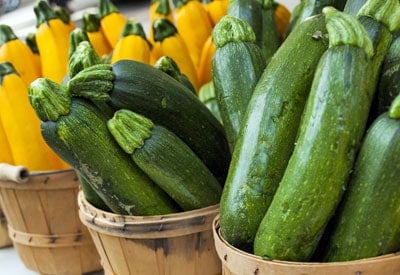Squash, including zucchini and gourds, are members of the cucumber (cucurbit) family and love to soak up the sun! They are easily damaged by frost and require rich, warm soil (70˚F or more), consistent water and up to 120 days to reach maturity; so make sure soil temperatures are warm and frost is long gone before you plant outside. Vines can wander 15 feet (or more!) in any direction, so give them plenty of room to roam.
Summer varieties — crookneck, patty pan and zucchini — are colorful and delicious raw or cooked. Winter varieties — acorn, butternut and spaghetti — with their vine-hardened rinds, are sweet and excellent for keeping. All require patience (and some work) to grow from seed, but are well worth the effort.
Squash is chock-full of amazing health benefits and has some impressive nutritional perks. It is low in fat and packed with dietary fiber, making it an extremely heart-friendly choice for culinary applications. Squash also contains high levels of vitamins A, C and E, and is a good source of anti-inflammatory compounds and many antioxidants, which help to lower your risk of infections and some forms of cancer.

FREE SHIPPING!
Squash Seeds
Summer squash — patty pan, crook neck and zucchini — are prolific and delicious.
View allHeirloom squash are prolific and delicious. Planting instructions are included with each seed packet and shipping is FREE!
Quick Guide: Planting, Growing & Harvesting Squash
- Choose from summer types (zucchini) or winter types (pumpkins)
- Start seeds indoors in cooler climates 3-4 weeks before last frost
- Plant seeds or seedlings into compost-rich soil in full sun
- Give them lots of space or plant beneath climbing crops like peas, corn, etc.
- Summer types mature in about 50 days, winter types in about 85-120 days, depending on the variety
- Pests and diseases include vine borers, squash bugs, cucumber beetles, and fungus
Site Preparation
Squash are warm-season annual plants which do best in full sun (may require partial shade in hotter environments) with ample water and nutrient-rich soil. Organic soil amendments, such as compost and aged manures, and slow-release plant nutrients, are effective when tilled into the soil prior to planting. Rotate your crops and do NOT plant in areas where other cucurbits have been cultivated over the past four years.
Tip: Use black plastic mulch throughout the summer season to warm the soil, prevent weeds and increase yields.
How to Plant
Sow three to four squash seeds in rows or hills 1-2 inches deep, depending upon their size. Space hills four feet apart. When the plants are 2-3 inches tall, thin to one sturdy plant or no more than two per hill. If gardening in cold, short-season climates, start seed indoors three to four weeks prior to planting. Cover seedlings with Harvest-Guard® row cover to provide additional warmth and protect them from insects.
Tip: Soil surrounding crops should remain moist at all times, however, plants are susceptible to fungal disease, so drip irrigation is best to avoid wetting the foliage. If overhead watering is necessary, water in the early morning so the foliage has time to dry during the day.

Harvesting and Storage
Harvest squash fruits when they are small and tender for best quality. All summer varieties should be harvested when they reach no more than 4-6 inches long and 1-1/2 to 2-1/2 inches in diameter. No one needs zucchini the size of baseball bats! Flowers are edible.
Use a sharp pruning knife to cut the fruit and at least 2-3 inches of the stem from the vine. Summer varieties will reach maturity in 45-50 days; winter varieties will take 85-110 days.
Wash and store summer varieties in the refrigerator for up to two weeks. Wipe soil from winter types and store clean in a cool, dry area with good ventilation.
Insect & Disease Problems
Various fungus and blights attack squash foliage. Spray infected plants with a dilute solution of copper spray or other broad-spectrum organic fungicide to help control the spread of disease. Squash vine borers, squash bugs and cucumber beetles are most damaging to plants, especially later in the season. Remove crop debris and rototill the garden after harvest to prevent future insect and disease problems.
Note: Leaves are easily burned by insecticidal soap and copper sprays. Use the most dilute concentration recommended. Do not spray plants in direct sun or when temperatures are above 80˚F.
Seed Saving Instructions
Plants will cross-pollinate, so isolate by 1/4 mile. Seeds should be taken from fruits that have gone past maturity by three weeks. Remove seeds, wash and let dry.











